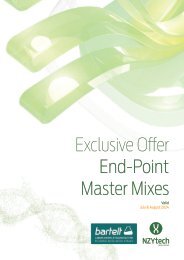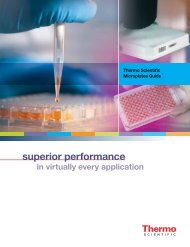PeloBiotech
Create successful ePaper yourself
Turn your PDF publications into a flip-book with our unique Google optimized e-Paper software.
www.pelobiotech.com<br />
Media for Cryo-Preservation<br />
The classical way to cryopreserve primary cells<br />
is the usage of the culture medium plus 10-<br />
20% FBS and 10% DMSO. After trypsination<br />
of adherent growing cells, neutralization of<br />
the used trypsin and centrifugation cells are<br />
resuspended in the freezing medium (e.g.<br />
Endothelial Cell Growth Medium + 10% FBS<br />
+ 10% DMSO).<br />
As alternative commercially available freezing<br />
media can be used (Cryo-ROS, Cell freezing<br />
medium and others) which contain 10%<br />
DMSO. These media are available and tested<br />
for different cell types e.g. blood cells,<br />
hematopoietic stem cells, melanocytes,<br />
macrophages, microglia and neural cells.<br />
In recent years companies approached into the<br />
market who are specialized in cryo-preservation and tissue storage media. One of our partners, BioLife Solutions, Seattle, has<br />
developed a series of DMSO containing cryo media which are produced under GMP conditions and are suitable and tested<br />
for a high number of cells. CryoStor CS 2, 5 and 10 is pre-formulated with USP grade DMSO of 2, 5 or 10%. The media is<br />
based on the novel HypoThermosol formula.<br />
Cryo-Preservation Media<br />
CryoStor®<br />
CryoStor® CS10 is a state-of-the-art cryopreservation medium designed to maximize postthaw<br />
cell recovery and viability in extremely low temperatures ranging from -70°C to -<br />
196°C. This ready-to-use solution is serum-free, animal component-free, and cGMPmanufactured,<br />
ensuring a safe and protective environment for the cryopreservation of a<br />
diverse array of sensitive cell and sample types. The formulation, containing 10% dimethyl<br />
sulfoxide (DMSO) along with other essential ingredients, is meticulously crafted with USP-grade components to minimize<br />
variability. This makes CryoStor® CS10 an ideal choice for e.g. preserving myeloma cell lines, human pluripotent stem<br />
cells, blood-derived cells.<br />
Available in various convenient formats, CryoStor® CS10 caters to the cryopreservation needs of B Cells, CHO Cells,<br />
Hematopoietic Stem and Progenitor Cells, Hybridomas, Intestinal Cells, Macrophages, Mesenchymal Stem and Progenitor<br />
Cells, Monocytes, Myeloma, NK Cells, Pluripotent Stem Cells, T Cells across different species, including Human, Mouse,<br />
Non-Human Primate, and Rat. Whether applied in Cord Blood Banking, Epithelial Cell Biology, Immunology, or Stem Cell<br />
Biology, CryoStor® CS10 stands out as an animal component-free, serum-free solution, ensuring the integrity and viability<br />
of preserved cells. We also offer the same with 2% and 5% DMSO.<br />
Cryo-Preservation by Vitrification<br />
Vitrification is the solidification of a liquid without crystallization and growth of ice. It is an ultrafast<br />
freezing method which is used for ES and iPS cells successfully. StemCell Keep is a DMSO-,<br />
serum-, protein- and xeno-free cryopreservation medium for ES/iPS cells by vitrification.<br />
Right: Vitrification is successful<br />
Left: Recrystallization happened vitrification failed)<br />
Procedure<br />
1. Just add StemCell Keep to your cells after centrifugation and transfer the vial within 1 minute to liquid nitrogen.<br />
2. Keep the vial for 1-2 minutes in liquid nitrogen and check the process.<br />
3. Store cells in your liquid nitrogen tank.<br />
34
















